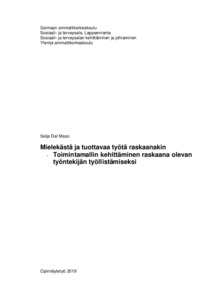Mielekästä ja tuottavaa työtä raskaanakin : Toimintamallin kehittäminen raskaana olevan työntekijän työllistämiseksi
Dal Maso, Selja (2019)
Dal Maso, Selja
2019
All rights reserved. This publication is copyrighted. You may download, display and print it for Your own personal use. Commercial use is prohibited.
Julkaisun pysyvä osoite on
https://urn.fi/URN:NBN:fi:amk-2019120825341
https://urn.fi/URN:NBN:fi:amk-2019120825341
Tiivistelmä
Opinnäytetyön tarkoituksena oli kehittää eräälle Saksan ensihoidon organisaatiolle yhtenäinen toimintamalli naispuolisten työntekijöiden työllistämiseksi äitiyssuojalain kriteerien edellyttämiin työtehtäviin raskauden aikana. Tavoitteena oli helpottaa raskaana olevien naisten työllistymistä organisaatiossa, pyrkien ylläpitämään heidän työmotivaatiota ja työhyvinvointia. Samalla otettiin huomioon työnantajan resurssit ja Saksan äitiyssuojalain mukanaan tuomat kriteerit.
Opinnäytetyö oli kolmivaiheinen tutkimuksellinen kehittämistyö. Ensimmäisessä vaiheessa kerättiin ryhmähaastattelujen avulla organisaation työntekijöiden kokemuksia, näkemyksiä ja odotuksia raskauden aikaisesta työllistymisestä. Toisessa vaiheessa haastattelujen tulokset analysoitiin ja analyysin tulokset esitettiin työryhmälle. Kolmannessa vaiheessa laadittiin toimintamallin runko työryhmässä tehdyn SWOT-analyysin ja siitä tehtyjen johtopäätösten pohjalta.
Haastattelujen avulla saatiin kattava kuva raskaana olevien työntekijöiden asemasta ja tilanteesta tällä hetkellä. Työntekijät olivat suurimmalta osin tyytymättömiä työllistymiseen raskauden aikana ja tunsivat sillä olevan suuri vaikutus työmotivaatioon sekä työhyvinvointiin. SWOT-analyysi osoitti, että yhtenäinen toimintamalli toisi etuja niin työnantajalle kuin työntekijälle parantaen työmotivaatiota, työhyvinvointia ja työntekijän sitoutumista organisaatioon.
SWOT-analyysin kautta saatiin toimintamallille laadittua hyvä runko, johon kerättiin haastatteluissa esiin nousseita ideoita raskauden aikaiseen työllistymiseen. Toimintamalli on hyvä laajentaa vielä myöhemmässä vaiheessa niin, että se käsittää myös ajanjakso ennen raskautta ja töihin paluu raskauden jälkeen. The aim of this thesis was to develop a coherent approach for the employment of female workers in a German primary care organisation in order to employ women employees during pregnancy. The aim was to facilitate the employment of pregnant women in the organisation, striving to maintain their motivation for work and wellbeing. The employer's resources and the criteria introduced by german Maternity Protection law were taken into account.
The thesis was a three-phase research development. The first step was to collect, through group interviews, the experiences, views and expectations about the employment of the employees of the organisation during pregnancy. In the second phase, interviews were analysed and the results of the analysis were presented to a working group. In the third phase, the framework for an approach was constructed based on a SWOT analysis made in the working group and its conclusions.
The interviews provided a comprehensive picture of the status and situation of pregnant workers at the moment. The majority of employees were unhappy with their employment during pregnancy and felt that it had a major impact on work motivation and occupational wellbeing. The SWOT analysis showed that a coherent approach would bring benefits both to the employer and to the employee, improving work motivation, well-being and employee engagement in the organization.
Through the SWOT analysis, it was possible to develop a good frame of the coherent, which gathered ideas from the interviews for employment during pregnancy. It is a good idea to extend this approach at a later stage to include the period before pregnancy and to the return to work after childbirth.
Opinnäytetyö oli kolmivaiheinen tutkimuksellinen kehittämistyö. Ensimmäisessä vaiheessa kerättiin ryhmähaastattelujen avulla organisaation työntekijöiden kokemuksia, näkemyksiä ja odotuksia raskauden aikaisesta työllistymisestä. Toisessa vaiheessa haastattelujen tulokset analysoitiin ja analyysin tulokset esitettiin työryhmälle. Kolmannessa vaiheessa laadittiin toimintamallin runko työryhmässä tehdyn SWOT-analyysin ja siitä tehtyjen johtopäätösten pohjalta.
Haastattelujen avulla saatiin kattava kuva raskaana olevien työntekijöiden asemasta ja tilanteesta tällä hetkellä. Työntekijät olivat suurimmalta osin tyytymättömiä työllistymiseen raskauden aikana ja tunsivat sillä olevan suuri vaikutus työmotivaatioon sekä työhyvinvointiin. SWOT-analyysi osoitti, että yhtenäinen toimintamalli toisi etuja niin työnantajalle kuin työntekijälle parantaen työmotivaatiota, työhyvinvointia ja työntekijän sitoutumista organisaatioon.
SWOT-analyysin kautta saatiin toimintamallille laadittua hyvä runko, johon kerättiin haastatteluissa esiin nousseita ideoita raskauden aikaiseen työllistymiseen. Toimintamalli on hyvä laajentaa vielä myöhemmässä vaiheessa niin, että se käsittää myös ajanjakso ennen raskautta ja töihin paluu raskauden jälkeen.
The thesis was a three-phase research development. The first step was to collect, through group interviews, the experiences, views and expectations about the employment of the employees of the organisation during pregnancy. In the second phase, interviews were analysed and the results of the analysis were presented to a working group. In the third phase, the framework for an approach was constructed based on a SWOT analysis made in the working group and its conclusions.
The interviews provided a comprehensive picture of the status and situation of pregnant workers at the moment. The majority of employees were unhappy with their employment during pregnancy and felt that it had a major impact on work motivation and occupational wellbeing. The SWOT analysis showed that a coherent approach would bring benefits both to the employer and to the employee, improving work motivation, well-being and employee engagement in the organization.
Through the SWOT analysis, it was possible to develop a good frame of the coherent, which gathered ideas from the interviews for employment during pregnancy. It is a good idea to extend this approach at a later stage to include the period before pregnancy and to the return to work after childbirth.
